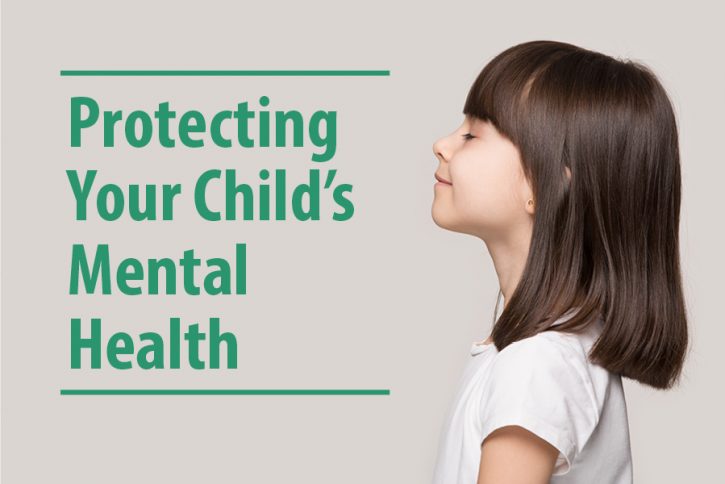
By Dr. Kimberly Kohli, PhD, FHP Psychiatry and Health Psychology
Article originally published on September 1, 2020.
We spend a lot of time concerned about our child(ren)’s physical health – are they eating the right foods? Staying active? Protecting themselves while playing? But how often do we take the same proactive approach to their mental health? The mental health of our children has been called to the forefront more than ever in the past year. This article will help you understand the facts about pediatric mental health and provide information on how to help maintain your child’s well-being.
Mental health refers to cognitive, behavioral and emotional well-being. It involves how a person thinks, feels and behaves. According to the Centers for Disease Control and Prevention, mental health in childhood means reaching developmental and emotional milestones, learning healthy social skills and being able to cope with problems. Mentally healthy children have a positive quality of life and can function well in school, at home and in their communities.
Mental health disorders in children are described as serious changes in the way children typically learn, behave or manage their emotions and cause distress and problems with getting through their day.
On this page:
- Facts about Children’s Mental Health in the United States
- Anxiety and Depression in Children
- Ways to Help Protect Your Child’s Mental Health
- Talking to Your Child about Mental Health
- If You Are Concerned about Your Child
- Resources
Facts about Children’s Mental Health in the United States
Attention Deficit Hyperactivity Disorder (ADHD), behavior problems, anxiety and depression are the most commonly diagnosed mental disorders in children.
1 in 6 children ages 2-8 years (17.4%) have a diagnosed mental, behavioral, or developmental disorder.
According to the Centers for Disease Control and Prevention:
- 4% of children ages 2-17 years (approximately 6.1 million) are diagnosed with ADHD
- 4% of children ages 3-17 years (approximately 4.5 million) are diagnosed with a behavior problem (such as Oppositional Defiant Disorder and Conduct Disorder)
- 1% of children ages 3-17 years (approximately 4.4 million) are diagnosed with an anxiety disorder
- 2% of children ages 3-17 years (approximately 1.9 million) are diagnosed with depression
The National Alliance on Mental Illness (NAMI) reports that 1 in 5 teenagers between 13-18 years old will experience at least one “severe mental disorder” during their life, as will roughly 13% of children ages 5-15 years.
Having another mental health disorder is most common in children with depression – about 3 in 4 children ages 3-17 years with depression also have anxiety (73.8%), and almost 1 in 2 have behavior problems (47.2%).
Behavior problems are more common among children ages 6-11 years than children younger or older.
Anxiety and Depression in Children
Many children have worries and fears and experience sadness from time to time. Strong fears may appear at different times during development. For example, toddlers are often distressed about being away from their caregivers, even if they are safe and cared for. Although fears and worries are typical in children, persistent or extreme forms of fear and sadness could be due to anxiety or depression. A child may be experiencing anxiety, if they do not outgrow the fears and worries that are typical in young children, or when there are so many fears and worries that these interfere with their daily activities, such as school, play activities or sleep.
Symptoms and Signs of Anxiety
- Extreme fear about a particular thing or situation (such as pets, bugs or visiting a doctor). This is also known as a phobia.
- Being very frightened of school and other social situations.
- Being very anxious about bad things happening in the future.
- Having repeated episodes of panic – moments of unexpected, sudden and intense fear with symptoms such as: pounding heart, difficulty breathing, sweating, shakiness or feeling dizzy
While feeling sad or hopeless occasionally is part of life for every child, persistent episodes of sadness or hopelessness may be signs of depression. Children experiencing depression may show a lack of interest in activities they used to enjoy or feel helpless in situations they are able to change.
Some children may not talk about their helpless or hopeless thoughts and may not appear sad. Depression may cause a child to act out or lose motivation, causing some to notice that the child is depressed, or others to inaccurately label the child as lazy or a troublemaker.
Symptoms and Signs of Depression
- Frequent feelings of sadness, hopelessness or irritability
- Lack of interest in fun activities
- Changes in eating patterns (eating more or less than usual)
- Changes in sleep patterns (sleeping more or less than usual)
- Differences in energy levels (frequently being very tired, sluggish, restless or tense)
- Difficulty with maintaining attention
- Feeling worthless, useless or guilty
- Self-injurious or self-destructive behavior
Depression can lead a child to suicidal thoughts or plan for suicide. Suicide is the second leading cause of death for those 10-24 years of age (behind accidents).
According to the CDC, suicide rates among those 10-24 years of age increased by 56% between 2007 and 2017. In 2017, there were 10.6 suicides per 100,000 people in this age range. When broken down by age groups, suicide rates for those between 10 and 14 almost tripled between 2007 and 2017. For teenagers ages 15-18, the rate surged 76% in that decade.
Sources:
Centers for Disease Control and Prevention (CDC)
Ways to Help Protect Your Child’s Mental Health
- Love your child unconditionally
- Encourage your children to talk about their feelings and validate their feelings
- Listen first, then talk
- Allow plenty of time for play and fun activities
- Discipline with respect and teaching, not shame
- Ask your child about their day
- Teach good sleep habits
- Encourage healthy foods
- Model positive self-care
- Let children be independent, when possible
- When sharing information, be honest with your children (at an age-appropriate level)
- Assist children with problem-solving
- Make time daily to talk with your children
Information obtained from: Parents with Confidence: 100 Everyday Ways to Strengthen Your Child’s Mental Health by Angela Pruess
Talking to Your Child about Mental Health
The first and most important step is to talk to children about mental health.
Model positive sharing about emotions and challenges. Many children, especially when young, will model the behavior of their caregivers. By being consistently open about the importance of mental health, you can lead by example. The best way to show a child it’s okay to acknowledge feelings is by talking about your own
According to Dr. Alexandra Hamlet, Psy.D., a clinical psychologist in the Mood Disorders Center at the Child Mind Institute, “Part of the stigma around mental health can be broken by us about being more matter of fact about it.” Dr. Hamlet recommends that we talk to children about mental illness, just as we talk about our physical illnesses.
When discussing mental health with your child, keep these tips in mind:
- Ask questions even when nothing is wrong.
- Communicate in a straightforward manner. Talking about mental health can be stressful, but be mindful of your emotions and body language – this will help the child to stay calm and feel more comfortable.
- Share information about your day when starting conversations.
- Observe your child’s reactions during the conversation.
- Remove any distractions so the child knows you are actively listening and not distracted.
- Emojis can really help younger kids communicate. Using a chart that shows emoji faces for children to point to can be helpful when your child is still learning how to verbally express their emotions.
- If a child is not comfortable talking to you, enlist help from someone else who you and your child trust.
- Communicate at a level that is appropriate to your child’s age and level of development.
If You Are Concerned about Your Child
Talk with your child’s teacher or caregivers. Ask what the child’s behavior is like at school, daycare or on the playground.
Talk with your child’s pediatrician. Describe your child’s behavior and report what you have observed and information shared by others.
Ask for a referral to a mental health professional who has experience and expertise with children. An evaluation by a mental health professional can help clarify underlying behavior problems and provide recommendations for next steps. This provides an opportunity to learn about your child’s strengths and weaknesses and determine which interventions might be most helpful.
Always seek immediate help if a child engages in unsafe behavior or talks about wanting to hurt themselves or others. Contact 911 immediately or take the child to the Emergency Department. Never leave a child alone, if you are concerned about them harming themselves or others.
Resources
Centers for Disease Control and Prevention (CDC) – Children’s Mental Health
Rewardcharts4kids.com – free printable emoji feelings charts and other free resources
Crisis Text Line – Text HOME to 741741 for free 24/7 support from a crisis counselor
Mental Health America – Youth Mental Health
National Institute of Mental Health (NAMI)
On Our Sleeves – The movement to transform children’s mental health
National Suicide Prevention Lifeline – 1-800-273-8255
Boys Town National Hotline (1-800-448-3000) – Serves all children, teens and parents and is open 24 hours per day, 356 days per year and staffed with trained counselors. Can provide support on issues such as anger, depression, school issues, bullying, etc.
The Trevor Project for LGBTQ youth (1-866-488-7386) – Provides crisis intervention and suicide prevention services to lesbian, gay, bisexual, transgender, queer and questioning youth.
Love is Respect National Abuse Helpline (1-866-331-9474) – 24-hour helpline for teens, parents, friends, and family.
National Domestic Violence Hotline (1-800-799-7233) or text TELLNOW to 85944 – 24-hour hotline for any type of domestic abuse, including dating abuse.
Substance Abuse Treatment Facility Locator (SAMHSA) – Searchable directory of drug and alcohol treatment programs, which shows the location of facilities around the country that treat substance abuse problems.
